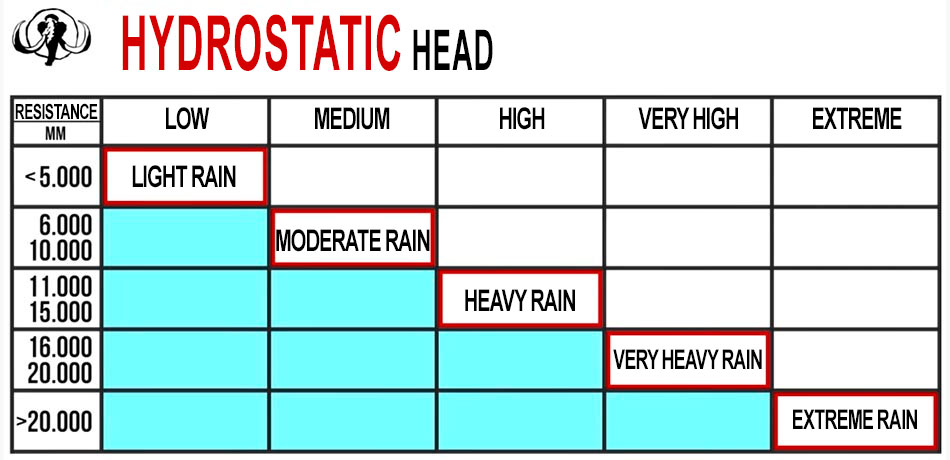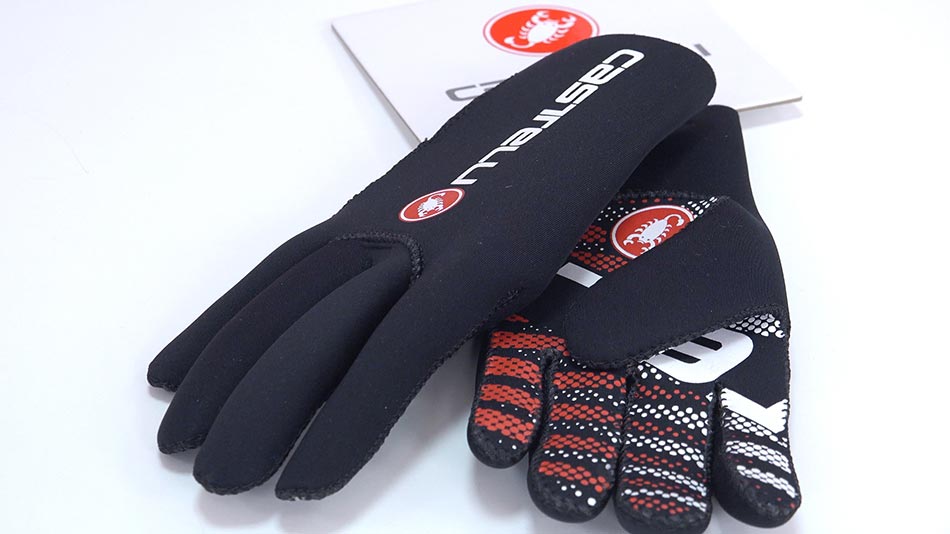Cycling in the rain can be a refreshing experience if you're prepared with the right gear. As with any outdoor activity, maintaining your body temperature is key, and this is best achieved with a layering system. Let’s dive into the different types of shell layers and their effectiveness against rain.
The primary requirement for a shell or outer layer is that it is either waterproof or water-resistant. Waterproofing is measured using the hydrostatic head (HH), which tests how high a column of water can be raised before it penetrates the fabric. The hydrostatic head you need depends on the weather conditions and how long you’ll be exposed to rain. For light rain, we recommend a minimum hydrostatic head of 5,000mm. Below is a chart that can help you choose the right option.

Breathability is another crucial factor to consider when selecting rainwear. This refers to the fabric's ability to release moisture, typically sweat, from your body. While waterproofing and breathability may seem contradictory, modern membranes and technical fabrics have found ways to combine both properties, albeit at a higher cost.
A cheap plastic rain jacket might suffice for a brief downpour, but for intense physical activity and prolonged exposure to rain, it becomes nearly impossible to maintain body temperature due to excessive sweating. On the opposite end of the spectrum, there's the legendary Gore-Tex®, offering a hydrostatic head of nearly 30,000mm and the highest level of breathability in a waterproof garment.
**Tip:** Always carry a dry base layer and gloves, safely stored in a waterproof bag in your backpack or tool kit. No matter how well you’re protected, it’s only a matter of time before you get wet, especially in heavy rain lasting for hours. Having a dry shirt and gloves can prevent hypothermia and let you complete your journey comfortably.
Try to strike a balance between waterproofing, breathability, and your budget based on the type of cycling you plan to do.
For your lower body, bib shorts with hydrophobic treatments and waterproof membranes in exposed areas like the lower back and knees are ideal. For extreme conditions or extended exposure, waterproof pants such as the Endura Hummvee Waterproof pant are preferable.

When it comes to gloves, different levels of breathability and waterproofing are available. However, for long cycling trips in the rain, only neoprene gloves provide adequate warmth and comfort, though they are not breathable. Hence, they are best suited for extreme conditions.

To keep your feet warm and dry, consider specialized boots with technical membranes, waterproof socks, and overshoes with varying degrees of thermal insulation and waterproofing, depending on the temperature.
**Tip:** Seal the cleat attachment points on your shoes to prevent water ingress. You can do this from the inside by placing duct tape under the insole to cover the cleat opening or seal external holes with silicone.
Lastly, pay close attention to the visibility of your clothing, as it decreases significantly in rainy conditions, especially on busy roads.
For more information on choosing the right clothing, check out the article on “The Layering System for Cycling†and this video on “How to Choose Rainwear for Cycling.â€
### Helmets and Glasses
In rainy weather, a waterproof helmet cover provides excellent protection. Some covers, like Velotoze, are latex-based and compatible with most helmets, making them quick and easy to use while taking up minimal space when not in use. An under-helmet with a technical membrane is especially beneficial in cold conditions.
Glasses are equally important, protecting your eyes from mud and water spray, which can make riding uncomfortable and unsafe. Many cyclists remove their glasses because they fog up or lenses get wet, obstructing vision. Here are some tips to minimize these issues.
To prevent fogging, use glasses without a tight wrap-around fit and, if possible, with anti-fog treatment and vent openings. Anti-fogging sprays are highly effective for all types of glasses.
Visors significantly reduce raindrops reaching your glasses, so they are highly recommended. If you’ve removed the visor from your helmet, reattach it when it rains. Alternatively, wear a cycling cap with a visor under the helmet if you don’t have a visor.
Photochromic lenses are great for uncertain weather conditions, adapting to changing light. However, if the ride is overcast with low light, clear lenses with UV protection are ideal.
### Rain Accessories
Other essential accessories include mudguards, lights, and bags with rain covers. Mudguards are indispensable for urban use and recommended even for road and mountain biking. They protect against dirt and water spray from the wheels, which can be heavier than the rain itself.
Lights are critical in reducing visibility in the rain, so use them even during the day, especially for urban and road use.
Finally, waterproof bags and panniers are essential for protecting items you carry on your rides, particularly in urban settings where delicate items like laptops, documents, and changes of clothes are commonly transported.
By following these tips, you can cycle comfortably even in the rain. All the products and professional advice mentioned are available at our Mammoth stores and online at [Mammoth Bikes](https://www.mammothbikes.com).
**Related Articles and Videos:**
- What is the Layering System for Cycling?
- How to Choose Cycling Rainwear
- Mudguards for MTB Topeak
- How to Choose Lights for Cycling
Battery Energy Storage System,Battery Energy,Lithium Battery,Lithium Ion Battery price,Pylontech Battery
Jiangyin Haoxuan Technology Co., Ltd. , https://www.haoxuan-tech.com
